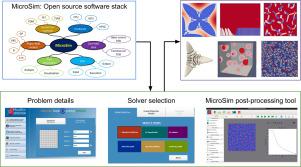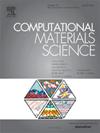MicroSim: A high-performance phase-field solver based on CPU and GPU implementations
IF 3.1
3区 材料科学
Q2 MATERIALS SCIENCE, MULTIDISCIPLINARY
引用次数: 0
Abstract
The phase-field method has become a useful tool for the simulation of classical metallurgical phase transformations as well as other phenomena related to materials science. The thermodynamic consistency that forms the basis of these formulations lends to its strong predictive capabilities and utility. However, a strong impediment to the usage of the method for typical applied problems of industrial and academic relevance is the significant overhead with regard to the code development and know-how required for quantitative model formulations. In this paper, we report the development of an open-source phase-field software stack that contains generic formulations for the simulation of multiphase and multi-component phase transformations. The solvers incorporate thermodynamic coupling that allows the realization of simulations with real alloys in scenarios directly relevant to the materials industry. Further, the solvers utilize parallelization strategies using either multiple CPUs or GPUs to provide cross-platform portability and usability on available supercomputing machines. Finally, the solver stack also contains a graphical user interface to gradually introduce the usage of the software. The user interface also provides a collection of post-processing tools that allow the estimation of useful metrics related to microstructural evolution.

MicroSim:基于 CPU 和 GPU 实现的高性能相场求解器
相场法已成为模拟经典冶金相变以及与材料科学相关的其他现象的有用工具。构成这些公式基础的热力学一致性使其具有很强的预测能力和实用性。然而,将该方法用于解决工业和学术界相关的典型应用问题的一个重大障碍是,定量模型公式化所需的代码开发和技术诀窍方面的巨大开销。在本文中,我们报告了开源相场软件栈的开发情况,该软件栈包含用于模拟多相和多组分相变的通用公式。求解器包含热力学耦合,可在与材料行业直接相关的场景中使用真实合金实现模拟。此外,求解器采用并行化策略,使用多个 CPU 或 GPU,提供跨平台可移植性,并可在现有的超级计算机上使用。最后,求解器堆栈还包含一个图形用户界面,用于逐步介绍软件的使用方法。用户界面还提供了一系列后处理工具,可以估算与微结构演变相关的有用指标。
本文章由计算机程序翻译,如有差异,请以英文原文为准。
求助全文
约1分钟内获得全文
求助全文
来源期刊

Computational Materials Science
工程技术-材料科学:综合
CiteScore
6.50
自引率
6.10%
发文量
665
审稿时长
26 days
期刊介绍:
The goal of Computational Materials Science is to report on results that provide new or unique insights into, or significantly expand our understanding of, the properties of materials or phenomena associated with their design, synthesis, processing, characterization, and utilization. To be relevant to the journal, the results should be applied or applicable to specific material systems that are discussed within the submission.
 求助内容:
求助内容: 应助结果提醒方式:
应助结果提醒方式:


